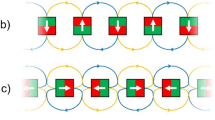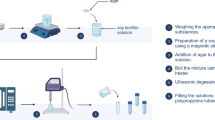Abstract
Signal void artifacts in gradient echo imaging are caused by the intra-voxel dephasing of the spins. Intra-voxel dephasing can be estimated by computing the field distribution on a sub-grid inside each picture element, followed by integration of all magnetization components. The strategy of computing the artifacts based on the integration of the sub-voxel signal components is presented here for different sub-grids. The coarseness of the sub-grid is directly related to computational effort. The possibility to save memory space and computing time for the dipole model by computing the field only on a sub-grid is addressed in the presented article. It is investigated as to how far computational time and memory space can be reduced by using an appropriate sub-grid. Numerical results for a model of a partially diamagnetically coated needle shaft are compared to experimental findings. In the case of a pure titanium needle, it is shown as being sufficient to compute the field distribution on a sub-grid that is at least four times coarser in each direction than the grid used to discretize the object in the related MR image. Due to three nested loops over the 3D grid, the need for memory space and time is saved by a factor 64. Deviations between measurements and simulations for the broad side of the artifact (uncompensated) and for the small side of the artifact (compensated) were 15.5%, respectively, 19.1% for orientation parallel to the exterior field, and 22.7%, respectively, 23.1% for orientation perpendicular to the exterior field.
Similar content being viewed by others
References
Lufkin RB, Gronemeyer DH, Seibel RM (1997) Interventional MRI: update. Eur Radiol 7(5):187–200
Pereira PL, Fritz J, Koenig CW, Maurer F, Boehm P, Badke A, Mueller-Schimpfle M, Bitzer M, Claussen CD (2004) Preoperative marking of musculoskeletal tumors guided by magnetic resonance imaging. J Bone Joint Surg Am 86A(8):1761–1767
Pereira PL, Günaydin I, Trübenbach J, Dammann F, Remy CT, Kötter I, Schick F, Koenig CW, Claussen CD (2000) Interventional MR imaging for injection of sacroiliac joints in patients with sacroiliitis. Am J Roentgenol 175:265–266
Gehl HB, Frahm C (1998) MRI-controlled biopsies. Radiologe 38(3):194–199
Mumtaz H, Harms SE (1999) Biopsy and intervention Working Group report. J Magn Reson Imaging 10(6):1010–1015
Gronemeyer DH, Seibel RM, Kaufman L (1991) Low-field design eases MRI-guided biopsies. Diagn Imaging (San Franc) 13(3):139–143
de Angelis GA, Moran RE, Fajardo LL, Mugler JP, Christopher JM, Harvey JA (2000) MRI-guided needle localization technique. Semin Ultrasound CT MR 21(5): 337–350
Jolesz FA, Blumenfeld SM (1994) Interventional use of magnetic resonance imaging. Magn Reson Q 10(2):85–96
Zhang Q, Chung YC, Lewin JS, Duerk JL (1998) A method for simultaneous RF ablation and MRI. J Magn Reson Imaging 8(1):110–114
Vogl TJ, Müller PK, Hammerstingl R, Weinhold N, Mack MG, Philipp C, Deimling M, Beuthan J, Pegios W, Riess H, Lemmens HP, Felix R (1995) Malignant liver tumors treated with MR imaging-guided laser induced thermotherapy: technique and prospective results. Radiology 196(1):257–265
Bui FM, Bott K, Mintchev MP (2000) A quantitative study of the pixel-shifting, blurring and non-linear distortions in MRI images caused by the presence of metal implants. J Med Eng Technol 24(1):20–27
Liu H, Martin AJ, Truwit CL (1998) Interventional MRI at high-field (1.5 T): needle artifacts. J Magn Reson Imaging 8(1):214–219
Ladd ME, Erhart P, Debatin JF, Romanowski BJ, Boesiger P, McKinnon GC (1996) Biopsy needle susceptibility artifacts. Magn Reson Med 36(4):646–651
Moscatel MA, Shellock FG, Morisoli SM (1995) Biopsy needles and devices: assessment of ferromagnetism and artifacts during exposure to a 1.5 T MR system. J Magn Reson Imaging 5(3):369–372
Melzer A, Schmidt A, Kipfmuller K, Gronemeyer DH, Seibel R (1997) Technology and principles of tomographic image-guided interventions and surgery. Surg Endosc 11(9):946–956
Schenck JF (1996) The role of magnetic susceptibility in magnetic resonance imaging: MRI magnetic compatibility of the first and second kinds. Med Phys 23(6):815–850
Fritzsche S, Thull R, Haase A (1994) Reduzierung von NMR-Bildartefakten durch Benutzung Optimierter Werkstoffe für Diagnostische Hilfsmittel und Implantate. Biomed Tech 39(3):42–46
Müller-Bierl B, Graf H, Steidle G, Schick F (2005) Compensation of magnetic field distortions from paramagnetic instruments by added diamagnetic material: measurements and numerical simulations. Med Phys 32(1):76–84
Lide DR (2004) CRC handbook of chemistry and physics. CRC Press, Boca Raton
Sinha S, Sinha U, Lufkin R, Hanafee W (1989) Pulse sequence optimization for use with a biopsy needle in MRI. Magn Reson Imaging 7:575–579
Lüdeke KM, Röschmann P, Tischler R (1985) Susceptibility artefacts in NMR imaging. Magn Reson Imaging 3:329–343
Posse S, Aue WP (1990) Susceptibility artifacts in spin-echo and gradient-echo imaging. J Magn Reson 88:473–492
Bakker CJG, Bhagwandien R, Moerland MA, Fuderer M (1993) Susceptibility artifacts in 2DFT spin-echo and gradient-echo imaging: the cylinder model revisited. Magn Reson Imaging 11:539–548
Bakker CJG, Bhagwandien R, Moerland MA, Ramos LMP (1994) Simulation of susceptibility artifacts in 2D and 3D Fourier transform spin-echo and gradient-echo magnetic resonance imaging. Magn Reson Imag 12(5):767–774
Bhagwandien R, van Ee R, Beersma R, Bakker CJG, Moerland MA, Lagendijk JJW (1992) Numerical analysis of the magnetic field for arbitrary magnetic susceptibility distributions in 2D. Magn Reson Imaging 10:299–313
Bhagwandien R, Moerland MA, Bakker CJG, Beersma R, Lagendijk JJW (1994) Numerical analysis of the magnetic field for arbitrary magnetic susceptibility distributions in 3D. Magn Reson Imaging 12:101–107
Kingsley PB (1995) Magnetic field gradients and coherence-pathway elimination. J Magn Reson B 109(3):243–250
Müller-Bierl B, Graf H , Lauer U , Steidle G, Schick F (2004) Numerical modeling of needle Tipp artifacts in MR gradient echo imaging. Med Phys 31(3):579–587
Müller-Bierl B, Graf H, Pereira P, Schick F (2005) Biopsy needles with markers: a numerical approach in assessing the influence of diamagnetic markers on needle artifacts. In: ICMP-BMT proceedings, Vol 368
Author information
Authors and Affiliations
Corresponding author
Rights and permissions
About this article
Cite this article
Müller-Bierl, B.M., Graf, H., Pereira, P.L. et al. Numerical Simulations of Intra-voxel Dephasing Effects and Signal Voids in Gradient Echo MR Imaging using different Sub-grid Sizes. Magn Reson Mater Phy 19, 88–95 (2006). https://doi.org/10.1007/s10334-006-0031-5
Received:
Accepted:
Published:
Issue Date:
DOI: https://doi.org/10.1007/s10334-006-0031-5




